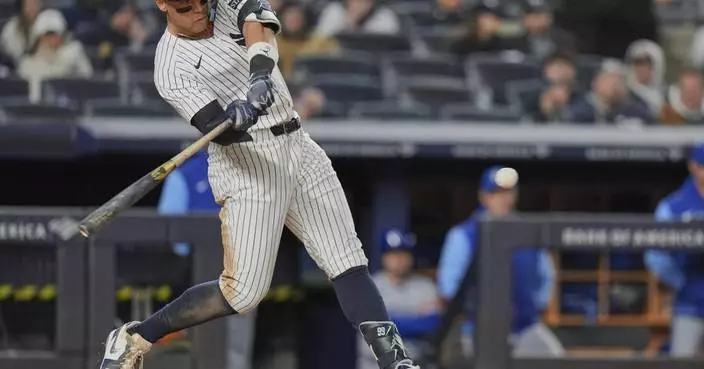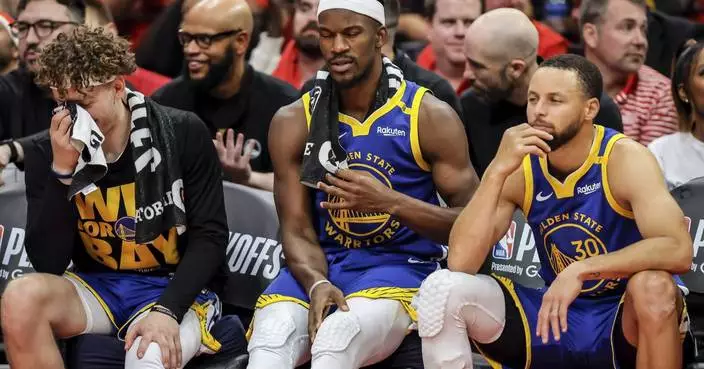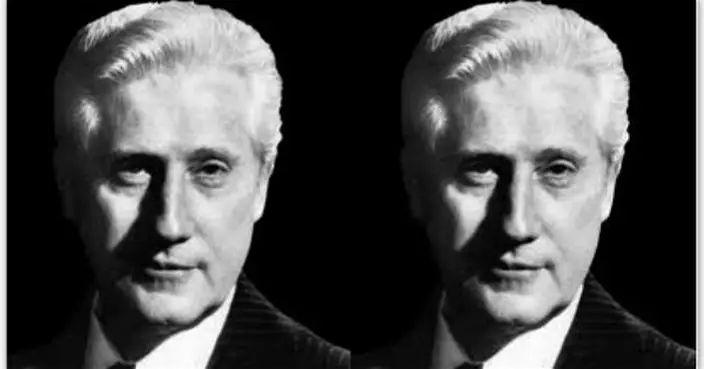From the age of 5, when she entered a government school in Myanmar, Stella Naw learned about the triumphs of Burman kings and heroes, recited Burman poems and performed Burman dances at school ceremonies.
Without realizing it, she was being torn from her ethnic roots and assimilated into the Southeast Asian country's dominant majority.
Click to Gallery
FILE - In this Dec. 18, 2013, file photo, ethnic Chin women of Muun sub-tribe, one with a traditional tattooed face and others with thanaka, a distinctive cosmetic face-paste widely used by Burmese women for a smoother skin, gather in Kyar Do village in Chin State, Myanmar. For decades the Karen, Shan, Mon, Chin and other minority groups have been put through a process they call Burmanization _ an informal system in which education, repressive laws, religious proselytization, economic exploitation and often brutal force are used to wash away their own identity. (AP Photo/Gemunu Amarasinghe, File)
FILE - In this Tuesday, Oct. 3, 2017, file photo, a large boat carrying Buddha images during the annual pagoda festival tours across the Inlay Lake, southern Shan State, Myanmar. Despite hopes that Aung San Suu Kyi’s civilian government would bring change, Myanmar continues to force Burman culture on its ethnic minorities through education, religious proselytization and often coercion. Despite close to 90 percent adherence to Christianity in the northern outlying regions, state-sanctioned Buddhist pagodas dominate the landscape. (AP Photo/Thein Zaw, File)
In this Nov. 8, 2017, photo, ethnic Karen school girls attend class at the headquarters of the 2nd Brigade of the Karen insurgents in the Taungoo area at Hto Lwe Wah, in Bago Region, Myanmar. The school includes a dormitory for over 200 students including these Karen young women where education is in Karen, English and Burmese languages. For decades the Karen, Shan, Mon, Chin and other minority groups have been put through a process they call Burmanization _ an informal system in which education, repressive laws, religious proselytization, economic exploitation and often brutal force are used to wash away their own identity. (AP Photo/Denis Grey)
FILE - In this Dec. 18, 2013, file photo, an ethnic Chin women of Muun sub-tribe with traditional tattooed face smokes a pipe with tobacco in Kyar Do village during a soccer tournament for villagers in Chin State, Myanmar. For decades the Karen, Shan, Mon, Chin and other minority groups have been put through a process they call Burmanization _ an informal system in which education, repressive laws, religious proselytization, economic exploitation and often brutal force are used to wash away their own identity. (AP Photo/Gemunu Amarasinghe, File)
+2
FILE - In this Dec. 18, 2013, file photo, ethnic Chin man Htang Ling Kaw, foreground, leaves the house of neighbor Laing Awi, background, at the Kyar Do village, Chin State, Myanmar. For decades the Karen, Shan, Mon, Chin and other minority groups have been put through a process they call Burmanization _ an informal system in which education, repressive laws, religious proselytization, economic exploitation and often brutal force are used to wash away their own identity. (AP Photo/Gemunu Amarasinghe, File)
FILE - In this Wednesday, Jan. 31, 2018, file photo, the moon rises behind the Uppatasanti Pagoda in Naypyitaw, Myanmar. Despite hopes that Aung San Suu Kyi’s civilian government would bring change, Myanmar continues to force Burman culture on its ethnic minorities through education, religious proselytization and often coercion. Despite close to 90 percent adherence to Christianity in the northern outlying regions, state-sanctioned Buddhist pagodas dominate the landscape. (AP Photo/Aung Shine Oo, File)
FILE - In this Dec. 18, 2013, file photo, ethnic Chin women of Muun sub-tribe, one with a traditional tattooed face and others with thanaka, a distinctive cosmetic face-paste widely used by Burmese women for a smoother skin, gather in Kyar Do village in Chin State, Myanmar. For decades the Karen, Shan, Mon, Chin and other minority groups have been put through a process they call Burmanization _ an informal system in which education, repressive laws, religious proselytization, economic exploitation and often brutal force are used to wash away their own identity. (AP Photo/Gemunu Amarasinghe, File)
FILE - In this Tuesday, Oct. 3, 2017, file photo, a large boat carrying Buddha images during the annual pagoda festival tours across the Inlay Lake, southern Shan State, Myanmar. Despite hopes that Aung San Suu Kyi’s civilian government would bring change, Myanmar continues to force Burman culture on its ethnic minorities through education, religious proselytization and often coercion. Despite close to 90 percent adherence to Christianity in the northern outlying regions, state-sanctioned Buddhist pagodas dominate the landscape. (AP Photo/Thein Zaw, File)
In this Nov. 8, 2017, photo, ethnic Karen school girls attend class at the headquarters of the 2nd Brigade of the Karen insurgents in the Taungoo area at Hto Lwe Wah, in Bago Region, Myanmar. The school includes a dormitory for over 200 students including these Karen young women where education is in Karen, English and Burmese languages. For decades the Karen, Shan, Mon, Chin and other minority groups have been put through a process they call Burmanization _ an informal system in which education, repressive laws, religious proselytization, economic exploitation and often brutal force are used to wash away their own identity. (AP Photo/Denis Grey)
FILE - In this Dec. 18, 2013, file photo, an ethnic Chin women of Muun sub-tribe with traditional tattooed face smokes a pipe with tobacco in Kyar Do village during a soccer tournament for villagers in Chin State, Myanmar. For decades the Karen, Shan, Mon, Chin and other minority groups have been put through a process they call Burmanization _ an informal system in which education, repressive laws, religious proselytization, economic exploitation and often brutal force are used to wash away their own identity. (AP Photo/Gemunu Amarasinghe, File)
FILE - In this Dec. 18, 2013, file photo, ethnic Chin man Htang Ling Kaw, foreground, leaves the house of neighbor Laing Awi, background, at the Kyar Do village, Chin State, Myanmar. For decades the Karen, Shan, Mon, Chin and other minority groups have been put through a process they call Burmanization _ an informal system in which education, repressive laws, religious proselytization, economic exploitation and often brutal force are used to wash away their own identity. (AP Photo/Gemunu Amarasinghe, File)
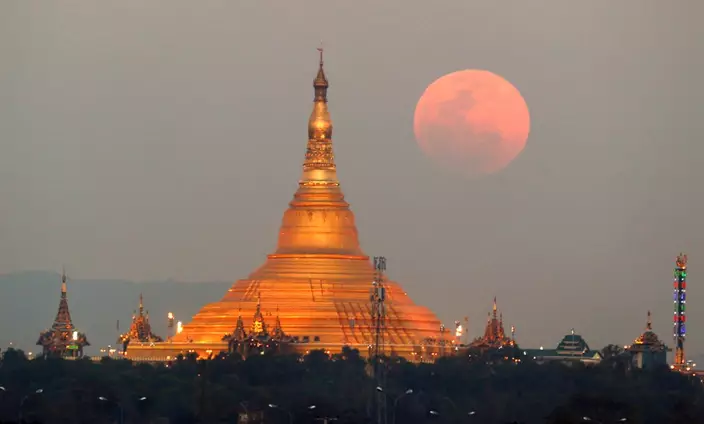
FILE - In this Wednesday, Jan. 31, 2018, file photo, the moon rises behind the Uppatasanti Pagoda in Naypyitaw, Myanmar. Despite hopes that Aung San Suu Kyi’s civilian government would bring change, Myanmar continues to force Burman culture on its ethnic minorities through education, religious proselytization and often coercion. Despite close to 90 percent adherence to Christianity in the northern outlying regions, state-sanctioned Buddhist pagodas dominate the landscape. (AP Photo/Aung Shine Oo, File)
"What was missing from my childhood was a chance to learn the culture and history of my own people, the Kachin," says the political analyst and writer. "I was ashamed to speak my own language. I didn't like the sound of my own name."
Naw's experience is shared by many of Myanmar's ethnic minorities, a multitude of more than 130 different groups with their own cultures, histories and languages who make up some 40 percent of the country's population. For decades the Karen, Shan, Mon, Chin and other minority groups have been put through a process they call Burmanization — an informal system in which education, repressive laws, religious proselytization, economic exploitation and often brutal force are used to wash away their own identity.
The recent violent expulsion from the country of nearly 700,000 Muslim Rohingya can be seen as an extreme example of the drive by central authorities to expunge any perceived threat to their dominance and stamp a Burman imprint on vast areas where minorities live. The United Nations calls it a "textbook example of ethnic cleansing."
This Burmanization dashes hopes that the end of direct military rule and election of Myanmar's first civilian government, headed by Aung San Suu Kyi, would usher in a new era of relations with minority groups. On taking power in early 2016, Suu Kyi declared that national reconciliation and a federal constitution would be high priorities.
Instead, the transition to democratic rule and its greater freedoms has come with a rise in nationalism and radical Buddhism. Suu Kyi has not condemned continuing military atrocities against the Kachin and others, and her stock with ethnic minorities has plummeted. Many say she is first and foremost a Burman.

FILE - In this Dec. 18, 2013, file photo, ethnic Chin women of Muun sub-tribe, one with a traditional tattooed face and others with thanaka, a distinctive cosmetic face-paste widely used by Burmese women for a smoother skin, gather in Kyar Do village in Chin State, Myanmar. For decades the Karen, Shan, Mon, Chin and other minority groups have been put through a process they call Burmanization _ an informal system in which education, repressive laws, religious proselytization, economic exploitation and often brutal force are used to wash away their own identity. (AP Photo/Gemunu Amarasinghe, File)
The military — which is constitutionally shielded from civilian oversight of all security matters — has long portrayed itself as Myanmar's savior, the only institution that could keep together a nation at risk of splitting into numerous parts.
It continues to battle the Kachin and groups in northern Shan State, working off the same playbook it has since independence from Britain in 1948 of violently suppressing ethnic insurgencies demanding greater autonomy. Those conflicts have been marked by human rights violations, the displacement of hundreds of thousands of rural people and the entrenchment of the military within ethnic communities.
Less obvious are what ethnic minorities insist are calculated efforts at Burmanization that focus on religion, language, heritage and other aspects of self-identity.
The government denies that it is pursuing such a policy.
Ko Ko Naing, a deputy director in the Ministry of Religious Affairs and Culture, says the government allows ethnic minorities to study their languages outside public schools even though it is not legally obligated to do so.
"That's why I don't see that the majority is Burmanizing the ethnic minority groups," he tells The Associated Press.

FILE - In this Tuesday, Oct. 3, 2017, file photo, a large boat carrying Buddha images during the annual pagoda festival tours across the Inlay Lake, southern Shan State, Myanmar. Despite hopes that Aung San Suu Kyi’s civilian government would bring change, Myanmar continues to force Burman culture on its ethnic minorities through education, religious proselytization and often coercion. Despite close to 90 percent adherence to Christianity in the northern outlying regions, state-sanctioned Buddhist pagodas dominate the landscape. (AP Photo/Thein Zaw, File)
It was also the duty of the government, the official says, to promote Buddhism and build Buddhist pagodas everywhere in the country lest "our religion and country disappear."
In Chin State, where 90 percent of Chin adhere to Christianity, crosses have been destroyed, pastors are intimidated and there is state-sponsored pressure to convert to Buddhism. Kachin State, where more than 90 percent of the Kachin people adhere to Christianity, has among the highest concentrations of pagodas in the country.
The government continues to pursue "a forced assimilation and indoctrination program" through boarding schools run by the military-controlled Ministry of Border Affairs, said Salai Za Uk Ling of the U.S.-based Chin Human Rights Organization. Education is offered free and is of a higher standard than in normal government schools, but activists say school authorities try to coerce students into converting to Buddhism.
Even the predominantly Buddhist Shan, the country's largest ethnic minority, are highly critical of pagodas built in a Burman rather than distinctive Shan style. A local saying sums it up: "When the Chinese conquer they build moats. When the Burmans conquer, they build pagodas."

In this Nov. 8, 2017, photo, ethnic Karen school girls attend class at the headquarters of the 2nd Brigade of the Karen insurgents in the Taungoo area at Hto Lwe Wah, in Bago Region, Myanmar. The school includes a dormitory for over 200 students including these Karen young women where education is in Karen, English and Burmese languages. For decades the Karen, Shan, Mon, Chin and other minority groups have been put through a process they call Burmanization _ an informal system in which education, repressive laws, religious proselytization, economic exploitation and often brutal force are used to wash away their own identity. (AP Photo/Denis Grey)
Still seared in the collective memory is the 1991 demolition of the Kengtung Palace, the grandest among those built by the former rulers of Shan State. In what Shan activists term a case of "cultural sabotage," rubble from the palace was scattered on roads around a military base.
Under the previous military-backed government of President Thein Sein, the regime eased earlier restrictions on teaching non-Burman languages but only allowed it after regular school hours, a policy that continues. Saw True Blood, a member of the Karen Development Network, says that about half of the 2,000 children living in his area of Taungoo in Karen State do not attend the after-school language classes because they are too tired, want to play or take extra tuition in other subjects.
Most Karen children, he says, can speak but not read or write their language. "When I hear my nieces and grandchildren speaking Burmese while they are playing, I tell them to speak Karen and ask, 'Are you Karen or Burman?"
The community leader says authorities tell the Karen that if they want to preserve their culture and identity they have to do it on their own, but at the same time place barriers to achieving this. He quotes a regional military commander as lecturing locals to "forget your ethnic identity, your territory. Just think about the Union."
"This is Burmanization," Saw True Blood says.

FILE - In this Dec. 18, 2013, file photo, an ethnic Chin women of Muun sub-tribe with traditional tattooed face smokes a pipe with tobacco in Kyar Do village during a soccer tournament for villagers in Chin State, Myanmar. For decades the Karen, Shan, Mon, Chin and other minority groups have been put through a process they call Burmanization _ an informal system in which education, repressive laws, religious proselytization, economic exploitation and often brutal force are used to wash away their own identity. (AP Photo/Gemunu Amarasinghe, File)
In recent years, the central government has Burmanized place names across the country, often making them unrecognizable to local people.
Last year, the naming of a new bridge across the Salween River in Mon State sparked demonstrations by the Mon. The bridge was named after General Aung San, the Burman hero of the independence struggle and Suu Kyi's father.
Mon activists say the name bears no relevance to their region, some likening it to a younger sibling being bullied by an older one. "The change of name made people feel a lot of pain in their heart. In spirit it means that the Burmans occupy the Mon," Min Soe Lin, a Mon member of parliament, told Australian researcher Cecile Medall late last year.
There has been some success in recent years at reaching cease-fire deals with ethnic rebel groups, including the Karen, who under the Karen National Union banner fought the world's longest running insurgency until 2012. But even the Karen leaders who signed the pact, which allowed them to keep their arms, have made it clear they have little trust in the truce, and clashes have broken out in recent weeks.

FILE - In this Dec. 18, 2013, file photo, ethnic Chin man Htang Ling Kaw, foreground, leaves the house of neighbor Laing Awi, background, at the Kyar Do village, Chin State, Myanmar. For decades the Karen, Shan, Mon, Chin and other minority groups have been put through a process they call Burmanization _ an informal system in which education, repressive laws, religious proselytization, economic exploitation and often brutal force are used to wash away their own identity. (AP Photo/Gemunu Amarasinghe, File)
In the hills outside Taungoo, senior leaders of the KNU agree the only way ethnic minorities will gain an equal voice in Myanmar is through a constitution that fully enshrines their rights under a genuine federal system. The current charter is highly centralized and was enacted by the military.
"Our grandfathers, fathers had to use military means to defend our culture and identity," says Padoh Eh Wah, a member of KNU Central Standing Committee. "Now we have to fight to have these guaranteed through political means."
Before World War II Myanmar's outer regions were largely left alone as they were not regarded as valuable, a sharp contrast to the ongoing scramble to exploit their forests, minerals and hydro-power by the military and its cronies, says political scientist James C. Scott, author of "The Art of Not Being Governed." Scott says a lack of opportunities in ethnic enclaves has sparked an exodus of minorities seeking a better chance elsewhere, leaving a vacuum that Burmans are filling.
"Is there an impulse to Burmanization? Absolutely," he says. "But I am doubtful how centralized and coordinated it is. I would be surprised if it is closely coordinated across ministries, since nothing much else is."
Ethnic leaders disagree. Naw, the Kachin political analyst, believes that "an organized, systematic, structural campaign by central institutions to Burmanize the country" is being carried out.
Saw True Blood, the Karen community leader, says beyond the threat of armed resistance, there is little stopping Burmans from taking all of his people's land.
"The Burmans have the power, government support, money, education," he says. "So they can get what they want."
BANGKOK (AP) — Hundreds of thousands of survivors desperately need humanitarian aid a month after Myanmar's deadly earthquake, compounded by airstrikes the military government is reportedly carrying out despite ceasefires meant to aid relief efforts during the country’s civil war.
The 7.7 magnitude March 28 quake hit a wide swath of the country, causing significant damage to six regions and states, including the capital, Naypyitaw. Myanmar’s Department of Meteorology and Hydrology reported Monday there had been 157 aftershocks after the big quake, ranging in magnitude from 2.8 to 7.5.
State-run MRTV television reported on Monday the quake’s death toll had reached 3,770, with 5,106 people injured and 106 still missing. The earthquake left many areas without power, telephone or cell connections and damaged roads and bridges, in addition to tens of thousands of buildings.
In some quake-hit areas, bereaved relatives and friends of the disaster’s victims on Monday offered donations to monks, a Buddhist tradition to transfer merit and blessings to the deceased. MRTV reported that Senior Gen. Min Aung Hlaing, head of the ruling military council, and his colleagues performed the same ceremony in Naypyitaw.
A report released Monday by the Myanmar Witness project of the London-based Centre for Information Resilience said the group had documented 80 post-quake airstrikes by the military across multiple regions, including 65 after the army declared its unilateral ceasefire on April 2, following similar declarations by its battlefield foes.
Myanmar has been in turmoil since the army’s 2021 takeover ousted the elected government of Aung San Suu Kyi, which led to nationwide peaceful protests that escalated into armed resistance, uniting pro-democracy activists and ethnic minority guerrilla groups that have long been fighting for autonomy.
“Myanmar’s population was already on its knees after years of SAC aggression and armed conflict,” said Myanmar Witness project director Robert Dolan, referring to the military’s ruling State Administration Council. “The layers of suffering are hard to comprehend — we’ve seen regions wrecked by war and then the earthquake, only to sustain further damage from continued airstrikes.”
The bombings have primarily targeted civilian areas — markets, residential zones, Buddhist monasteries, and Christian churches — resulting in the deaths of over 200 civilians, including at least 24 children, from March 28 to April 19, 2025, according to a statement from the shadow National Unity Government, the main opposition group coordinating resistance to military rule.
Dave Eubank, a former U.S. Army Special Forces soldier who founded the Free Burma Rangers, a private aid organization, said two of his medics had been killed in military attacks since the earthquake, which have primarily struck villages.
“These attacks have not slowed down at all, attacks by drones, airstrikes, mortars and artillery continue unabated,” said Eubank, who was in Myanmar when the earthquake hit but is currently outside the country, though his teams continue to operate there.
“They have been widespread and lethal, mostly to villagers — very few of the resistance have been killed by them.”
The military government hasn’t directly commented on the airstrikes, but when it extended its ceasefire on April 22, it reserved the right to respond as “necessary” to certain activities by the resistance forces.
U.N. agencies and other humanitarian organizations, meanwhile, stress that living conditions remain dire for earthquake survivors.
Even before the earthquake, the civil war had displaced more than 3 million people and left nearly 20 million in need.
“Critical needs remain for safe shelter, clean water and sanitation, physical and mental health care, comprehensive protection services and cash assistance,” the United Nations Office for the Coordination of Humanitarian Affairs said Friday in its latest situation report.
Many who lost their homes are still in makeshift tents with little to protect them from pre-monsoon storms ahead of the months-long rainy season, which normally begins in May, and limited access to safe drinking water and clean sanitation raises the threat of waterborne diseases, the U.N. said.
The International Federation of Red Cross and Red Crescent Societies said in a report released Monday that displaced people were living outdoors in temperatures of up to forty degrees Celsius (104 degrees Fahrenheit), with an overwhelming fear of further aftershocks.
In Naypyitaw, the damaged buildings of the labor and foreign ministries have been demolished for new construction, said a resident who asked not to be named for security reasons. Debris at markets and schools has been cleaned by municipal workers, while thousands of people, who lost their homes, were still living under tarpaulin sheets, he said.
He said that he was told that the departments and offices of several ministries will be temporarily relocated to Yangon, the country’s former capital and largest city, until their offices can be rebuilt.
Associated Press writer David Rising contributed to this report.
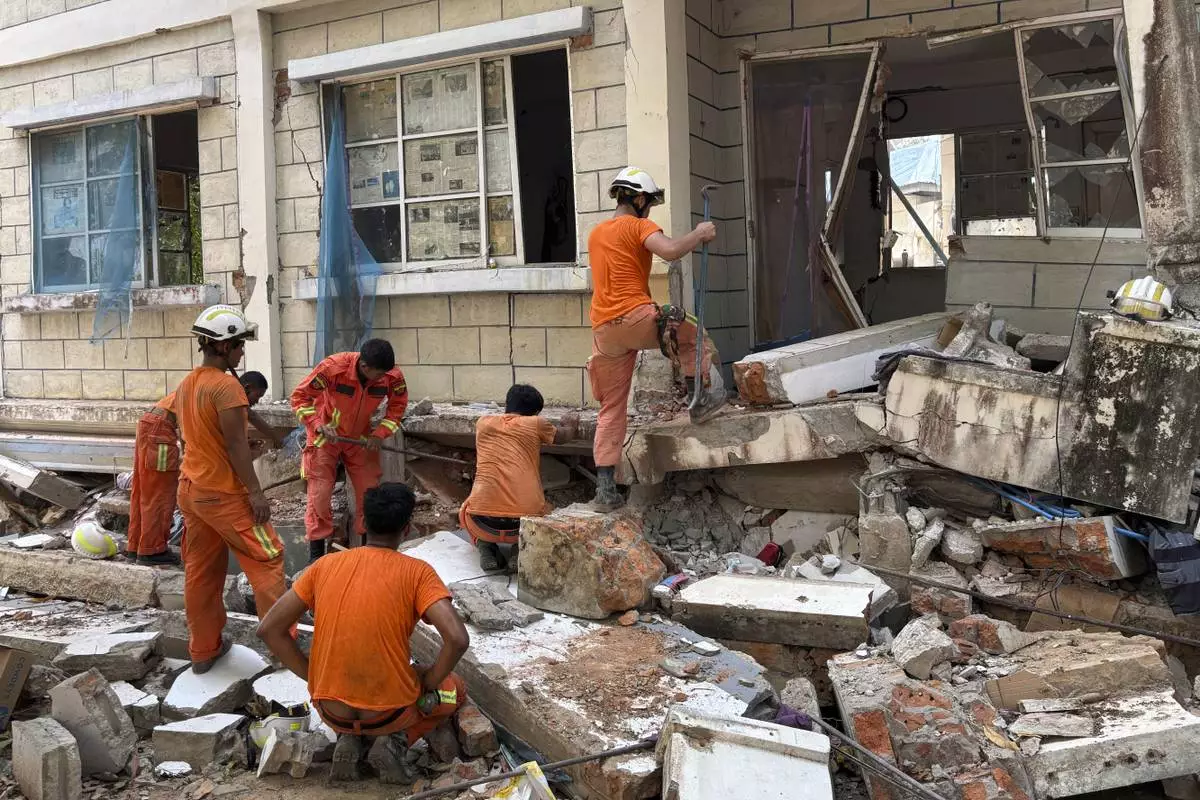
Firefighters recover the belongings of victims of the earthquake from damaged buildings that house Governments' servants in Naypyitaw, Myanmar, Monday, April 28, 2025. (AP Photo/Aung Shine Oo)

A firefighter recovers the belongings of victims from damaged buildings that house Governments' servants in Naypyitaw, Myanmar, Monday, April 28, 2025, one month after the earthquake. (AP Photo/Aung Shine Oo)

A damaged building is seen in Naypyitaw, Myanmar, Monday, April 28, 2025, one month after the earthquake. (AP Photo/Aung Shine Oo)

A damaged building is seen in Naypyitaw, Myanmar, Monday, April 28, 2025, one month after the earthquake. (AP Photo/Aung Shine Oo)

A damaged building is seen in Naypyitaw, Myanmar, Monday, April 28, 2025, one month after the earthquake. (AP Photo/Aung Shine Oo)

A damaged building is seen in Naypyitaw, Myanmar, Monday, April 28, 2025, one month after the earthquake. (AP Photo/Aung Shine Oo)

A damaged building is seen in Naypyitaw, Myanmar, Monday, April 28, 2025, one month after the earthquake. (AP Photo/Aung Shine Oo)

A damaged building is seen in Naypyitaw, Myanmar, Monday, April 28, 2025, one month after the earthquake. (AP Photo/Aung Shine Oo)

A damaged building is seen in Naypyitaw, Myanmar, Monday, April 28, 2025, one month after the earthquake. (AP Photo/Aung Shine Oo)

A damaged building is seen in Naypyitaw, Myanmar, Monday, April 28, 2025, one month after the earthquake. (AP Photo/Aung Shine Oo)

A damaged building is seen in Naypyitaw, Myanmar, Monday, April 28, 2025, one month after the earthquake. (AP Photo/Aung Shine Oo)

A damaged building is seen in Naypyitaw, Myanmar, Monday, April 28, 2025, one month after the earthquake. (AP Photo/Aung Shine Oo)

A volunteer sits collapsed building after one month of the strong earthquake, in Naypyitaw, Myanmar, Monday, April 28, 2025. (AP Photo/Aung Shine Oo)

Volunteers help to clear a collapsed building after one month of the strong earthquake, in Naypyitaw, Myanmar, Monday, April 28, 2025. (AP Photo/Aung Shine Oo)

Volunteers help to clear collapsed buildings after one month of the strong earthquake in Naypyitaw, Myanmar, Monday, April 28, 2025. (AP Photo/Aung Shine Oo)

Volunteers help to clear collapsed building after one month of the strong earthquake in Naypyitaw, Myanmar, Monday, April 28, 2025. (AP Photo/Aung Shine Oo)

Volunteers help to clear debris of a collapsed building after one month of the strong earthquake in Naypyitaw, Myanmar, Monday, April 28, 2025. (AP Photo/Aung Shine Oo)

Volunteers help to clear collapsed buildings after one month of the strong earthquake in Naypyitaw, Myanmar, Monday, April 28, 2025. (AP Photo/Aung Shine Oo)

A volunteer drives a backhoe to clear debris of a building at a market, after one month of the strong earthquake in Naypyitaw, Myanmar, Monday, April 28, 2025. (AP Photo/Aung Shine Oo)

A volunteer drives a backhoe to clear debris of a building at a market, after one month of the strong earthquake in Naypyitaw, Myanmar, Monday, April 28, 2025. (AP Photo/Aung Shine Oo)

A women walks past damaged buildings at a market, after one month of the strong earthquake in Naypyitaw, Myanmar, Monday, April 28, 2025. (AP Photo/Aung Shine Oo)

People watch as a backhoe clear debris from damaged buildings at a market, after one month of the strong earthquake in Naypyitaw, Myanmar, Monday, April 28, 2025. (AP Photo/Aung Shine Oo)

A Buddhist novice monk walks past damaged buildings at a market, after one month of the strong earthquake in Naypyitaw, Myanmar, Monday, April 28, 2025. (AP Photo/Aung Shine Oo)

A Buddhist novice monk walks past damaged buildings at a market after one month of strong earthquake in Naypyitaw, Myanmar, Monday, April 28, 2025. (AP Photo/Aung Shine Oo)
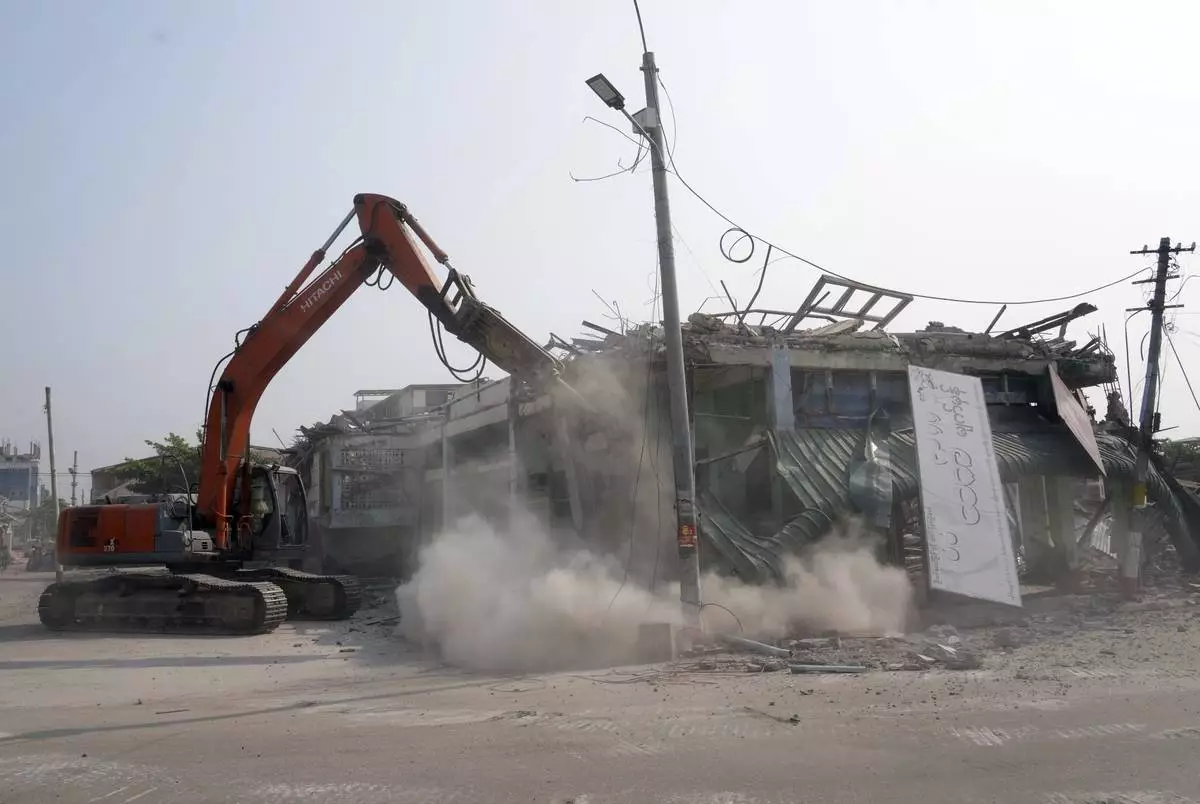
A volunteer drives a backhoe to clear debris of a building at a market, after one month of the strong earthquake in Naypyitaw, Myanmar, Monday, April 28, 2025. (AP Photo/Aung Shine Oo)

A volunteer drives a backhoe to clear debris of a building at a market, after one month of the strong earthquake in Naypyitaw, Myanmar, Monday, April 28, 2025. (AP Photo/Aung Shine Oo)

A volunteer drives a backhoe to clear debris of a building at a market, after one month of the strong earthquake in Naypyitaw, Myanmar, Monday, April 28, 2025. (AP Photo/Aung Shine Oo)








































